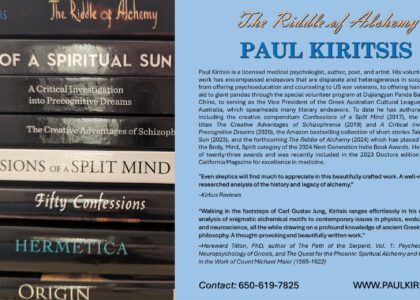
Nowadays, you can be almost certain that anyone who has received a formal education knows how to write an essay. I, for one, remember the extent to which all primary, as well as secondary school teachers of English used to go to instil within all students what obviously forms the rudimentary and core framework of all well-written literature. Naturally, I expected to see these literary norms applied by those entrants who responded to one of the two essay questions comprising the “It’s all Greek to me” writing competition, and especially by students or graduates of English and English literature! But in scrying the entries, I realised this wasn’t the case. Many people threw around some very deep, speculative, philosophical and meditated thoughts with respect to both questions, but their arguments were all over the place! There was no logical progression to their opinions, no discernible structure.
When it comes to answering a competition question or any essay question in general, there are certain structural elements that must be adhered to. An essay, a minor thesis or a longer dissertation, whether written to address issues in English, literature, history, drama, philosophy, psychology or any other denomination of cultural, artistic or scientific inquiry, follows a certain triune format deemed universal. Typically, it is broken up into three main sections; an introduction, a body and a conclusion.
The first section, the introduction, serves multiple purposes. Save for obviously introducing the topic at hand, it provides any necessary background information and establishes context. With respect to the just mentioned, this should be limited to encapsulate only that which is most relevant. One should always remember that when it comes to addressing specific issues in essays, brevity, specificity and clarity of expression are all key players for success. In the introduction, the writer should also expound his or her statement of intent and their intended line/s of argument. Typically, an introduction will be about a paragraph in length and comprise ten percent of the entire content. In more comprehensive works i.e. minor or major theses it can be several paragraphs in length. Always try to narrow the introductory perspective to a monocular vision which includes only what is most relevant to the essay topic. This will set up the necessary boundaries which will not only guide you through the rest of the essay, but also keep you from bouncing around quite a bit and going off into sidereal space with themes and issues not particularly relevant to your field of inquiry. (You’d be surprised how easy it is to do this!)
The corpus of the essay is called the body, or main body if you like. It comprises roughly eighty to ninety percent of the written content, and is exclusively focused on presenting anecdotal, documented or academic evidence to support a main contention or hypothesis already illumined in the introduction. In the body, each paragraph presents a unique topic usually expressed as a one-line sentence and subsequently develops that vantage point it through the presentation of supporting and requisite evidence–for scientific issues this would be past research into the respective field of inquiry; alternatively, for historiographical, cultural and literary issues this would be unique perspectives drawn from first-hand accounts or sources. In no way, shape or form should you introduce new issue or topic of discussion mid-paragraph, or refer to statements or arguments mentioned in former paragraphs (unless they are directly related to the current topic). Doing this will emasculate the strength of your argument by breaking up its natural flow and logical progression. All paragraphs within the main body should conclude with a sentence which conveys the primal essence of its key theme or topic. There is obviously no limit to the number of paragraphs contained within the main body, save perhaps when one is keeping to a word limit imposed by a mediating authority. Word limits are usually prerequisites or requirements for essays written in high school, or for university undergraduate and some postgraduate assessments. A scrupulously and well-written essay will always link the main points presented in each paragraph in such a way that the piece flows in a progressive, logical format and thus appeals to deductive reasoning. In this way, any superficial demarcations that might exist between each point are melded together. This is a pivotal and defining characteristic of all A-grade essays.
The final section of an essay is called the conclusion. It is usually one paragraph in length, or alternatively it can be comprised of two or three, depending of course on the length of the dissertation. A conclusion need not make up more than ten percent of the entire work. In the context of the whole essay, the conclusion sums up the argument by reintegrating the hypothesis or main contention, as well as repeating all the main points presented at the inception of each paragraph. As with the introduction, the conclusion should operate within a narrow field of vision so that it relates to and addresses the essay question explicitly. Here, one should take extra care as to not inaugurate any new themes or issues. On the other hand it is much desired to mention any wider implications or future directions that relate to your denomination of inquiry, and transcribe a final comment which encapsulates your entire argument.
This is the conventional format, akin to the set procedures and formulae we encounter in mathematical methods to solve quadratic, exponential and linear equations. It allows for an audience to follow their reader without the risk of feeling they’re little more than a passive observer at the Mad Hatter’s Tea Party. In other words, it prevents alienation through stimulus overload or an inversion of logical sequence which makes an argument difficult to follow, let alone try to grasp and understand. Remember all of creation sings to the fundamental pattern that is structure. Mother Nature herself garners expression and comprehension through the golden ratio, a dialect of mathematics. You can have a powerful statement and irrefutable evidence to support your point of view or perspective, but its potency will be annulled and it will subsequently sink back into a primordial ocean of chaos unless you adhere to the conventional structure. Thoughts, ideas and opinions foster beliefs which in turn facilitate mass movements, but it’s safe to say that their written or oral doubles will remain inert and defunct unless conveyed in an intelligible and clear manner!








